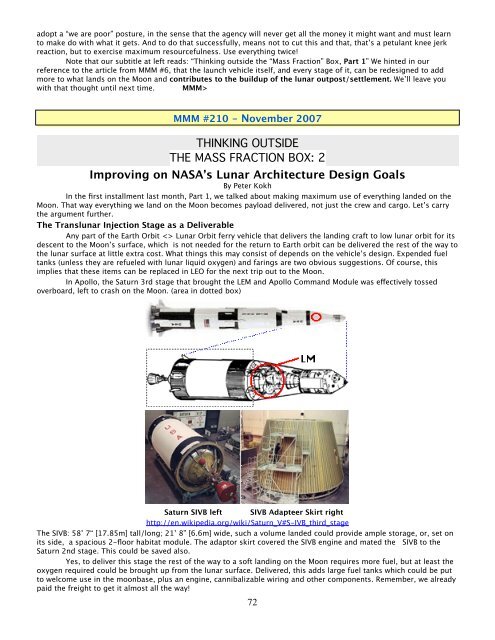Space Transportation - mmmt_transportation.pdf - Moon Society
Space Transportation - mmmt_transportation.pdf - Moon Society
Space Transportation - mmmt_transportation.pdf - Moon Society
You also want an ePaper? Increase the reach of your titles
YUMPU automatically turns print PDFs into web optimized ePapers that Google loves.
adopt a “we are poor” posture, in the sense that the agency will never get all the money it might want and must learn<br />
to make do with what it gets. And to do that successfully, means not to cut this and that, that’s a petulant knee jerk<br />
reaction, but to exercise maximum resourcefulness. Use everything twice!<br />
Note that our subtitle at left reads: “Thinking outside the “Mass Fraction” Box, Part 1” We hinted in our<br />
reference to the article from MMM #6, that the launch vehicle itself, and every stage of it, can be redesigned to add<br />
more to what lands on the <strong>Moon</strong> and contributes to the buildup of the lunar outpost/settlement. We’ll leave you<br />
with that thought until next time. MMM><br />
MMM #210 - November 2007<br />
THINKING OUTSIDE<br />
THE MASS FRACTION BOX: 2<br />
Improving on NASA’s Lunar Architecture Design Goals<br />
By Peter Kokh<br />
In the first installment last month, Part 1, we talked about making maximum use of everything landed on the<br />
<strong>Moon</strong>. That way everything we land on the <strong>Moon</strong> becomes payload delivered, not just the crew and cargo. Let’s carry<br />
the argument further.<br />
The Translunar Injection Stage as a Deliverable<br />
Any part of the Earth Orbit Lunar Orbit ferry vehicle that delivers the landing craft to low lunar orbit for its<br />
descent to the <strong>Moon</strong>’s surface, which is not needed for the return to Earth orbit can be delivered the rest of the way to<br />
the lunar surface at little extra cost. What things this may consist of depends on the vehicle’s design. Expended fuel<br />
tanks (unless they are refueled with lunar liquid oxygen) and farings are two obvious suggestions. Of course, this<br />
implies that these items can be replaced in LEO for the next trip out to the <strong>Moon</strong>.<br />
In Apollo, the Saturn 3rd stage that brought the LEM and Apollo Command Module was effectively tossed<br />
overboard, left to crash on the <strong>Moon</strong>. (area in dotted box)<br />
---Saturn SIVB left -- ---SIVB Adapteer Skirt right<br />
http://en.wikipedia.org/wiki/Saturn_V#S-IVB_third_stage<br />
The SIVB: 58’ 7“ [17.85m] tall/long; 21’ 8” [6.6m] wide, such a volume landed could provide ample storage, or, set on<br />
its side, a spacious 2-floor habitat module. The adaptor skirt covered the SIVB engine and mated the SIVB to the<br />
Saturn 2nd stage. This could be saved also.<br />
Yes, to deliver this stage the rest of the way to a soft landing on the <strong>Moon</strong> requires more fuel, but at least the<br />
oxygen required could be brought up from the lunar surface. Delivered, this adds large fuel tanks which could be put<br />
to welcome use in the moonbase, plus an engine, cannibalizable wiring and other components. Remember, we already<br />
paid the freight to get it almost all the way!<br />
72















